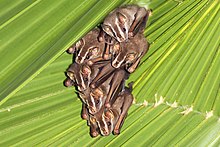Tent-making bat
| Tent-making bat | |
|---|---|
 |
|
| Scientific classification | |
| Kingdom: | Animalia |
| Phylum: | Chordata |
| Class: | Mammalia |
| Order: | Chiroptera |
| Family: | Phyllostomidae |
| Genus: | Uroderma |
| Species: | U. bilobatum |
| Binomial name | |
|
Uroderma bilobatum Peters, 1866 |
|
The tent-making bat (Uroderma bilobatum) is an American leaf-nosed bat (Phyllostomidae) found in lowland forests of Central and South America. This medium-sized bat has a gray coat with a pale white stripe running down the middle of the back. Its face is characterized by a fleshy noseleaf and four white stripes. Primarily a frugivore, it may supplement its diet with insects, flower parts, pollen, and nectar. Its common name comes from its curious behavior of constructing tents out of large, fan-shaped leaves. These roosts provide excellent protection from the tropical rains, and a single tent roost may house several bats at once. This bat is quite common in its geographic range; hence, its conservation status is listed as Least Concern.
The bat Uroderma bilobatum is a member of the family Phyllostomidae, which contains 49 genera and a greater variety in feeding habits than any other bat family. Carnivores, frugivores, and bats that specialize on blood or nectar and pollen are all represented in this family. Commonly known as the American leaf-nosed bats, phyllostomids are characterized by a special structure consisting of a leaf-shaped projection extending up from a “horseshoe-shaped” base attached to their upper lip. These bats send their echolocation calls out their nostrils, and so the noseleaf may help direct the sounds that they emit. Because they emit calls at such low frequencies, standard bat detectors have trouble picking up their calls. Thus they are sometimes called “whispering bats”.
Within Phyllostomidae is the subfamily Stenodermatinae, members of which are sometimes called tailless bats. These 17 genera from Central America have broad shoulders and faces and narrow tail membranes, with a tail that is either greatly reduced or absent. The upward projection of their noseleaf has two creases and the lower part is at least partly free. The shape of their faces has been correlated to their frugivorous diet. They are known to pick fruit with their mouths and carry it to a night roost to consume it. Thus, they are important seed dispersers for certain plants.
Bats in the genus Uroderma are characterized by a pale, white stripe that runs down the back and two pairs of white stripes on the face. Their tail membrane is curved into the shape of a U and lacks hair along its edge. This genus includes two species: Uroderma bilobatum Peters, 1866 and Uroderma magnirostrum Davis, 1968.
Uroderma bilobatum includes six subspecies:
The genus name Uroderma comes from the Greek words uro for “tail” and derma for “skin”, thus meaning “tail of skin”. This describes their tail membrane, which is made entirely of skin, lacking tail vertebrae. The species name bilobatum comes from the Greek and Latin roots bi for “two” and lobat for “lobed” in reference to their first upper incisors, which have two lobes.
...
Wikipedia

